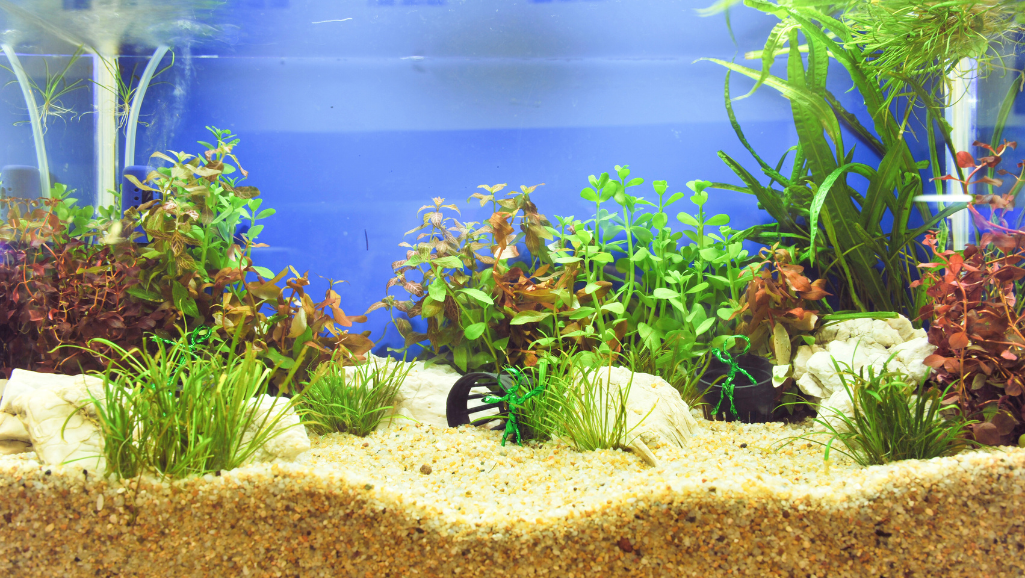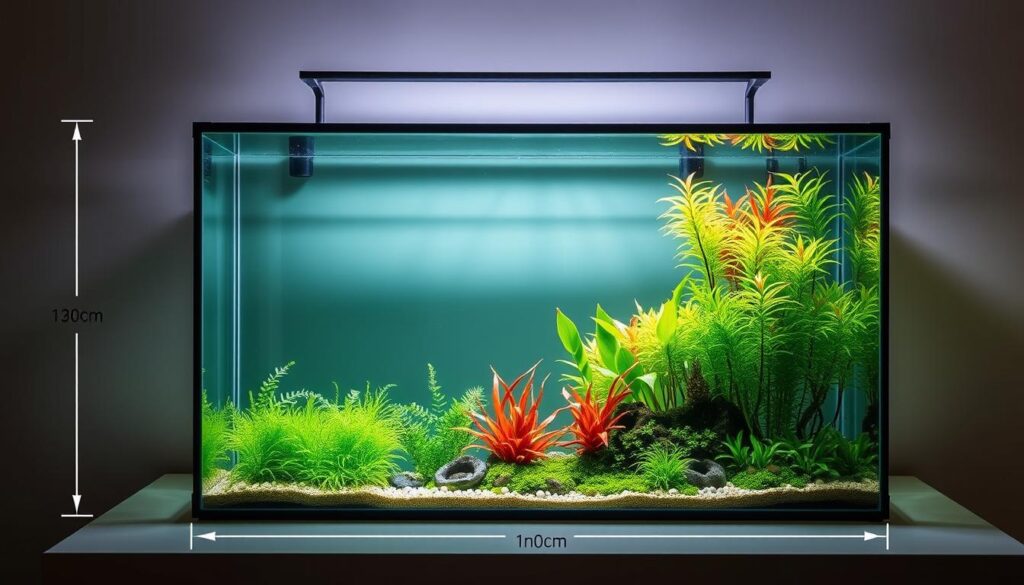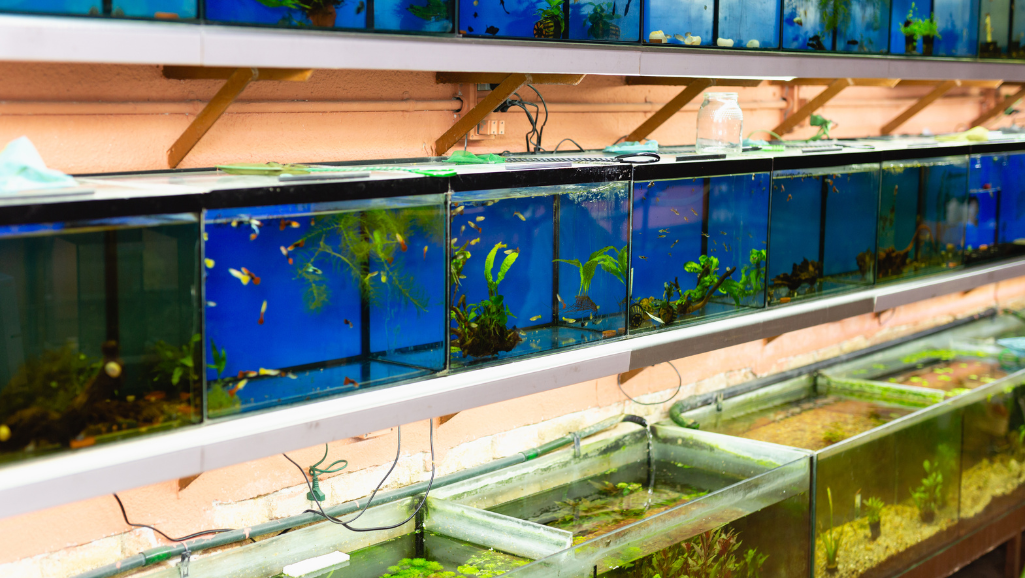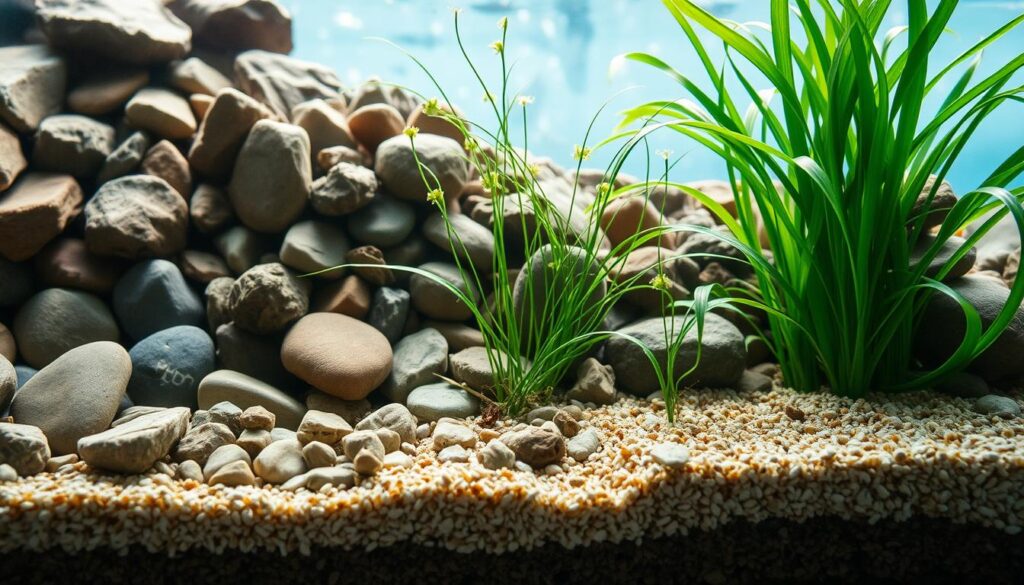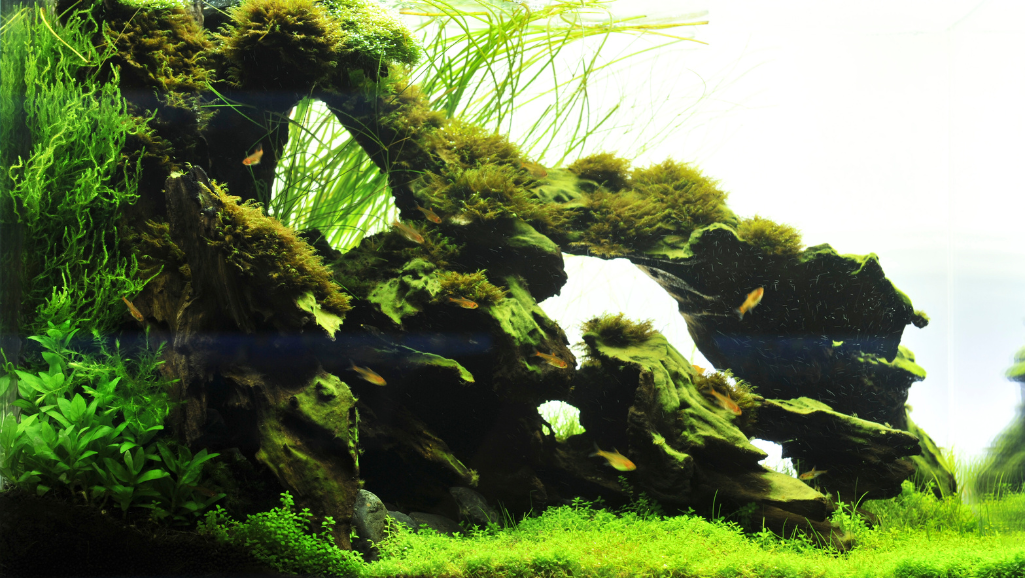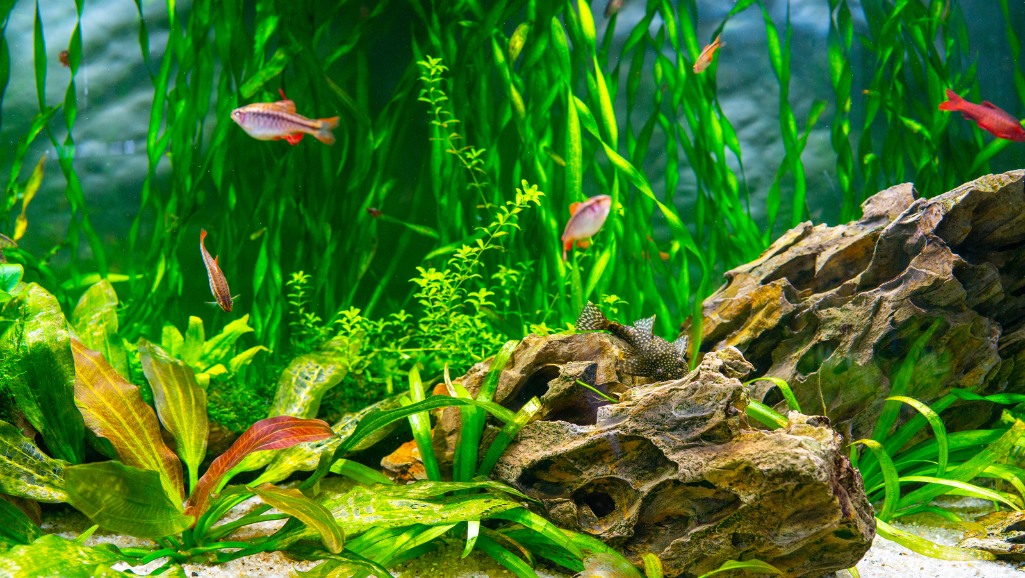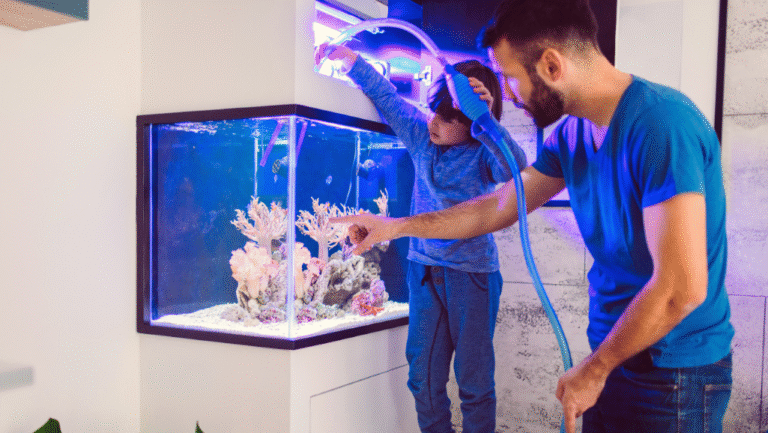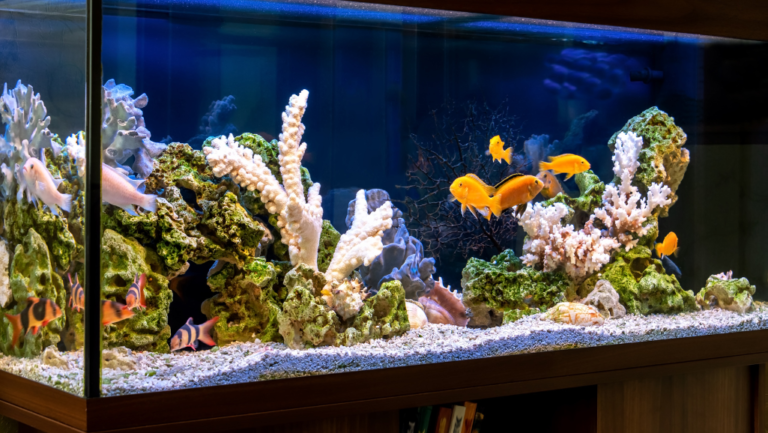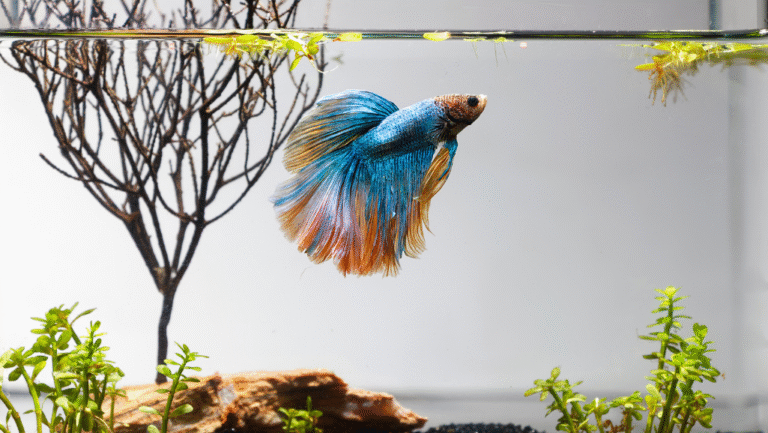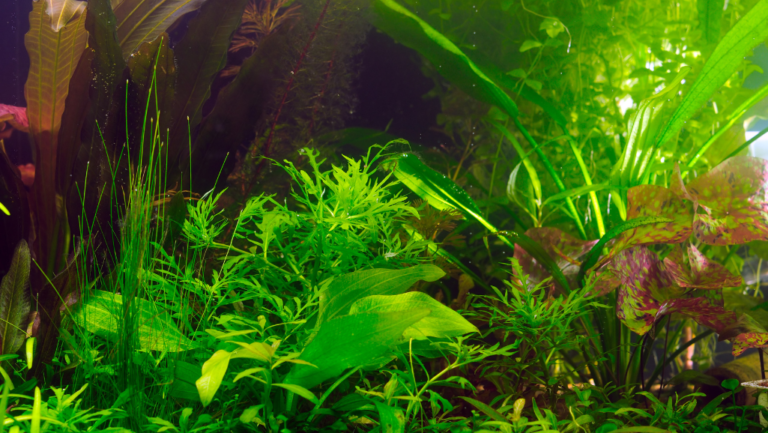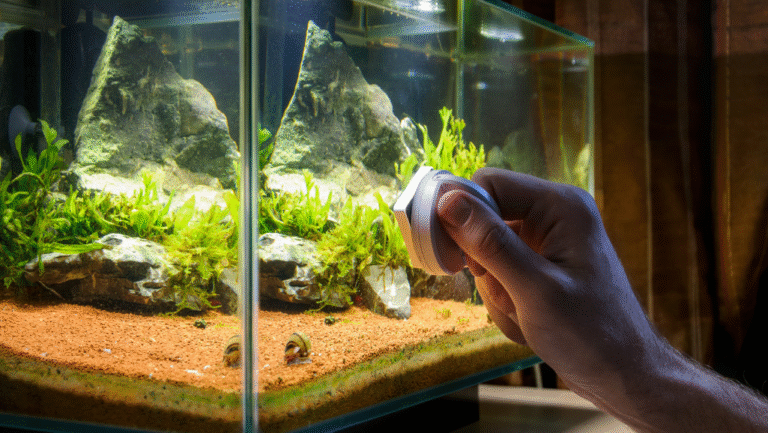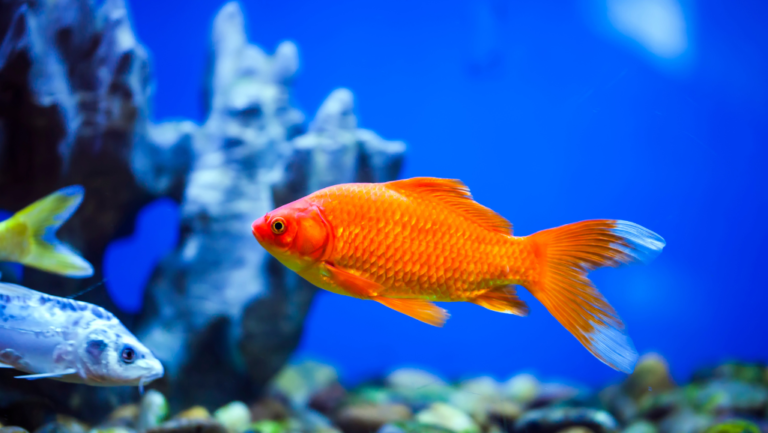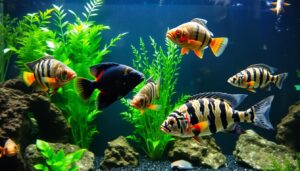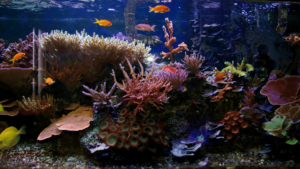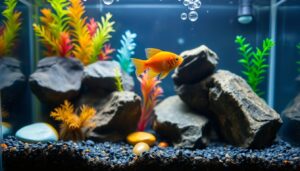Turn a glass tank into living art. Carefully chosen plants, rocks, driftwood, and substrate combine to create calming, natural scenes you can enjoy every day.
This buyer’s guide walks you through the essentials — from compact 7.13 gallon cube sets like Mr Aqua Pure to larger rimless show displays such as Miotke’s 71-gallon options. Learn which supplies arrive in a kit and what extras help plants and fish thrive in clear, balanced water.
We’ll show how design choices — Dutch, Jungle, Iwagumi, or nature aquarium styles — change the look and upkeep of your tanks. You’ll also get tips for spotting restocks and curated gear from U.S. retailers like Glass Aqua so you can time purchases well.
Key Takeaways
- Start with style: pick a nature aquarium look that fits your space and skill level.
- Check what a kit includes and what extra supplies you’ll need for healthy water and plants.
- Smaller cubes suit beginners; rimless show tanks offer dramatic views and more room to design.
- Watch retailer stock and restocks to grab popular models and curated gear.
- Combine creative design with reliable equipment for a setup that thrives over time.
Why Choose an Aquascape Aquarium Kit Today
Choosing the right set simplifies decisions and helps you create a calming green scene in any room. A curated aquascape tank bundles compatible parts so your vision moves quickly from idea to living display.
Transforming your space with living design
Good lighting and reliable filtration amplify plant growth and keep fish healthy. That balance makes the tank a low-stress focal point that softens busy spaces.
Starter sets also speed learning. You’ll see growth sooner and pick up skills like layout, trimming, and routine care without hunting for matching components.
- Compatibility: No mismatched parts means less setup friction.
- Design focus: Spend time on layout and aquatic plants instead of gear choices.
- Stock timing: When restock appears, you can claim the size and style that suits your room and routine.
Understanding the aquascape aquarium kit
Start by knowing what arrives in the box and what you’ll need to add later for a complete planted display.
What’s included vs. what you add: Entry-level packages often include the glass tank, a matched light, and basic filters — the Mr Aqua Pure 7.13 Gallon example at $129.99 shows this well. Premium sets may add clearer glass, refined finishes, or enhanced hardware, as with higher-priced shrimp versions and 10-gallon scaper bundles priced near $299.95.
What you’ll usually order: substrate, rocks, driftwood, plants, tools, and optional CO2. These supplies shape your layout and long-term costs.
Kit value compared to piecemeal builds
Curated packages cut guesswork and compatibility problems. A balanced light and filter combo saves time and reduces returns.
- Verify inclusions: some bundles add stands or media; others stay minimal.
- Plan upgrades: pick common dimensions and filter formats for easy future changes.
- Check support: return policies and parts info matter for maintenance and fish health.
Core components: tank, light, filter, and more
The right combination of tank, light, filter, and substrate sets the stage for long-term success. Start by pairing a level stand and tank designed to share the load. UNS rimless tanks and matching stands give a gallery look while protecting seams and glass.
Tank and stand synergy for stability and style
Pick furniture rated for filled weight. A sturdy base preserves glass joins and keeps lines clean for rimless displays.
Tip: If a kit skips a stand, verify your furniture supports water, rocks, and driftwood weight before filling.
Lighting that drives plant growth and color
Choose a light that balances output and color rendition. Chihiros WRGB II Slim LED & Shade Kits are popular for vivid greens and reds.
Use shades or diffusers to aim lighting where carpets or background stems need it most. That reduces glare and helps control algae.
Filtration for crystal-clear, healthy water
Match filter turnover to tank volume and scape density. Combine mechanical, biological, and chemical media to polish water and grow beneficial bacteria.
Quick-disconnect hoses and accessible inlets make routine cleaning easier and cut maintenance time.
Substrate and hardscape as your design foundation
Lay nutrient substrate where roots will anchor and use stones and driftwood to shape sightlines. SevenPorts options like Dragon, Ohko, and Seiryu rocks pair well with nutrient bases.
Rinse rocks, test-fit the filter and light, and plan cable paths before the final fill to avoid surprises.
- Keep tools handy: tool-friendly access speeds trimming and cleaning.
- Plan media: layered filter media stabilizes water for fish and plants.
- Preflight: test-fit components and pre-rinse hardscape to start clean.
Right size, right impact: gallons, dimensions, and placement
Picking the right tank size shapes both the visual impact and daily routine of your living display. Think about how the unit will fit, how much time you can commit, and where it will make the most impact.
From compact cubes to rimless showpieces
Small rooms shine with the 7.13 gal cube, which measures 11.8 x 11.8 x 11.8 inches. It fits tight nooks and offers a quick, low-maintenance project.
For cinematic depth, consider a 30 gallon rimless at 35.4 x 11.8 x 17.7 inches or the Miotke 71 gal at 35.4 x 23.6 x 19.7 inches. Larger tanks create sweeping views and richer plant scenes.
Measuring for fit, viewing, and maintenance
Measure inches carefully for stand footprint and wall clearance. Allow swing room for hoses, tools, and easy access to the filter and light.
Tip: Place tanks away from direct sun and busy walkways to keep conditions steady for plants and fish.
- Match ambition with access: bigger tanks handle swings better but need more water and time.
- Height matters: eye-level tanks feel immersive and cut neck strain during long viewing sessions.
- Power and layout: ensure outlets are nearby and elevated; neat cable management boosts safety and style.
Order a size that fits your maintenance cadence. A well-chosen set keeps the hobby joyful long after setup day.
Aquascaping styles to guide your kit choice
Style choices shape both the look and the work required to keep a planted display healthy and beautiful. Pick a direction early and your gear, plants, and maintenance plan will fall into place.
Dutch: plant-focused abundance
Go Dutch if you love layered rows, color contrasts, and frequent pruning. This style emphasizes dense groups of stem plants and varied textures.
It asks for good lighting and steady nutrient dosing to keep carpets and tall stems thriving. Expect regular trims and a hands-on part in shaping the scene.
Jungle: wild, low-maintenance depth
The Jungle look favors large-leafed species, tangles of roots, and forgiving growth. It suits shy fish and owners who prefer relaxed upkeep.
Use broad plants and driftwood to create hiding places. This design reduces the need for precision trimming and helps cycle bio-load naturally.
Iwagumi: rock-led minimalism
Iwagumi centers on hero rocks and open space. A few stones create a meditative focal point and contrast with low carpets.
This approach needs clear sightlines, tidy planting, and careful rock placement. It benefits from open floor area in the tank and crisp optics.
Nature Aquarium: a snapshot of the wild
Nature scenes mimic hills, riverbanks, or forest paths using stones, driftwood, and mixed plants. The goal is believable depth and movement.
Longer tanks suit sweeping valleys; cubes highlight vertical wood forms. Review stock and layout photos for inspiration and plant lists before buying materials.
- Match style to gear: plant-heavy designs need stronger lights and stable CO2; rock-led layouts need space and clear views.
- Gather ideas: collect aquascaping ideas and note plant lists, stone angles, and spacing before you commit.
- Plan your role: some styles require precise trimming; others allow a more relaxed, natural pace.
Lighting essentials: LED output, spectrum, and control
Good lighting defines how plants show color and how a tank feels in a room. Choose lights that balance brightness and color to highlight reds and greens without washing tones out.
WRGB spectrum for vivid greens and reds
WRGB-calibrated LEDs render leaf color faithfully. Chihiros WRGB II Slim LED Light & Shade Kits offer that range and let you tune color for dramatic contrast.
Matching intensity to plant selection
Match output to species: low-light epiphytes need moderate illumination, while carpets demand higher PAR near the substrate.
Tip: Adjust mounting height and spread to avoid hotspots and ensure even growth across the foreground and background.
Timers and shades for algae management
Use timers to set a stable photoperiod—start at 6–8 hours—to limit algae during the first growth phase.
Shades cut spill, focus energy into the layout, and make living spaces more comfortable. Pair light upgrades with balanced nutrients and CO2 when pushing for faster growth.
- Monitor plant response for two weeks and tweak intensity incrementally.
- Keep lenses clean with a microfiber tool to sustain output and protect your light investment.
Filtration and water treatment for thriving plants and fish
Clean, balanced water is the invisible foundation that lets plants flourish and fish behave naturally. Pairing flow and chemistry gives your display stamina and reduces surprises.
Mechanical, biological, and chemical balance
Effective filtration blends three roles: capture debris, grow beneficial bacteria, and polish water.
- Mechanical: pads and prefilters trap waste before it clogs media.
- Biological: porous media nurture colonies that break down ammonia and nitrite.
- Chemical: resins or carbon remove odors and occasional toxins.
Water conditioners, parameters, and stability
Use a trusted water conditioner at every change to neutralize chlorine and chloramine. Track temperature, pH, KH, and GH to keep conditions steady.
- Match filter size to bioload and plant density so flow is gentle but consistent.
- Clean prefilters often but leave bio-media intact to preserve bacteria.
- Keep spare impellers and O-rings for fast maintenance and less downtime.
Substrates and gravel: fueling root growth and layout
The base layer you pick affects how plants anchor, feed, and reveal their best colors.
Choose enriched bases when you plan heavy rooting plants. Nutrient-rich substrate feeds root-feeders and brings out vivid foliage. For hardscape-led layouts or epiphyte-focused designs, inert sand or gravel keeps chemistry stable and highlights stones or wood.
Nutrient-rich bases versus inert sands
Enriched soils supply long-term nutrients and reduce early dosing. They work best under heavy feeders and tall stems.
Inert sands and gravels are ideal when plants get nutrients from the water column or from root tabs, and when you want a clean, hardscape-forward look.
Grain size, slope, and long-term maintenance
Mix grain sizes for texture and stability. Use finer grains in the front to help carpets root, and coarser grains toward the back to resist compaction.
- Sculpt a forward slope to create depth and guide debris to an easy-to-clean zone.
- Add root tabs under heavy feeders to extend nutrient life and preserve color between rescapes.
- Rinse inert gravels well to cut early clouding; avoid over-rinsing enriched soils so nutrients remain.
Plan maintenance with a light gravel vacuum on open areas and minimal disturbance near dense roots. A small, precise tool makes spot cleaning simple and protects growth momentum.
For a deeper dive on the best substrate options, see this guide to the best substrate options and choose supplies that match your planting goals and long-term vision.
Hardscape choices: rocks, stones, and driftwood
The right stones and driftwood turn glass into a landscape you want to visit every day. Hardscape choices set scale, guide plant placement, and shape movement for fish in tanks of any size.
Seiryu, Dragon (Ohko), and lava: color, texture, scale
Seiryu stone lends cool grays and crisp veins that create dramatic focal points. Use it for clean lines and contrast with green carpets.
Dragon (Ohko) shows warm, weathered texture and natural pockets. It’s ideal where you want easy planting pockets and a lived-in look.
Black lava rock is porous and lightweight. Build height without heavy mass per cubic inches, and combine with gravel accents for natural transitions.
Driftwood types and anchoring techniques
Choose Malaysian or spider wood for sweeping branches that add depth. Pre-soak pieces to reduce buoyancy and tannins.
- Anchor methods: pin driftwood to slate, zip-tie it to stones, or bury bases in substrate for stability.
- Dry-test layouts until the composition clicks. Small rotations reveal lines that frame plant groups.
- Repeat stone types and angles for cohesion; consistent lighting color helps rock tones feel intentional.
Tip: Plan caves and overhangs for shelter, but keep swim lanes open so fish move naturally. Keep tools nearby for micro-adjustments before the first fill to save hours of rework.
Planting the aquascape: species, stocking, and layout
Layering plants by height and role gives an instant sense of depth and purpose to your layout.
Map foreground carpets, midground clumps, and tall background stems to pull focus toward your main hardscape lines. This simple design trick creates believable scale and a guided viewing path.
Foreground carpets, midground accents, background height
Start dense in the front to outcompete algae and speed stable growth. Mix easy epiphytes like Anubias and Bucephalandra with statement species such as Crinum for drama and balance.
Low-tech versus high-tech plant selections
For low-tech setups, pick hardy plant species and moderate light. For high-tech builds, add CO2 and stronger light plus regular trimming to reward faster growth.
“Rinse new plants and inspect for hitchhikers before planting — a tidy start cuts early cleaning.”
- Use tweezers and scissors as essential tool items for precise placement and trims.
- Feed root feeders through substrate and dose the water column for stems and epiphytes.
- Introduce fish only after plants root and parameters stabilize so livestock and layout settle together.
Livestock harmony: shrimp, nano fish, and bioload
Good stocking choices make your planted display calm, clear, and lively.
Match stock to filter capacity
Build a plan that respects your filter and planted density. A modest load keeps water clear and behavior natural.
- Estimate bioload by species, not just numbers.
- Stage additions so beneficial bacteria in the filtration can catch up.
- Keep spare sponges and a small quarantine tub ready for new arrivals.
Shrimp and nano fish choices
Shrimp are excellent cleaners and add delicate motion in plant-rich layouts.
Pair them with calm nano fish that won’t see juveniles as snacks. Tight shoals work well in open lanes; peaceful species suit dense jungles.
Feeding, compatibility, and care
Feed lightly and consistently. Overfeeding clouds water and stresses plants and animals.
Research temperament and adult size before you stock. That prevents predation and keeps community dynamics stable.
Preventing algae: balance, cleaning, and routine
Algae growth is a symptom — and balance is the cure: meter light, nutrients, and filtration to steady the system. A predictable routine keeps water clear and lets plants thrive. Small, consistent steps protect the look and health of your tank.
Light, nutrients, and CO2 equilibrium
Keep light, nutrients, and CO2 in sync. Excess of any one invites algae, while balance favors healthy plants. Start with a conservative photoperiod and raise it slowly as growth stabilizes.
Do regular partial water changes to export dissolved organics before they fuel blooms.
Targeted cleaning tools and time-saving tips
Use targeted tools — razor scrapers, a soft toothbrush, and a fine airline — to clear glass, rocks, and crevices without harming roots.
- Clean filters on schedule but avoid over-sanitizing so beneficial bacteria stay intact.
- Prune plants before they shade themselves; open canopies improve light and flow.
- Feed fish modestly and remove uneaten food to cut nutrient spikes and save time.
Routine beats emergency. A brief weekly check keeps an aquarium looking its best and cuts major cleaning needs later.
Compare kits: beginner-friendly to premium builds
Not every size or price point fits every hobbyist. Decide whether you want a simple starter or a statement display before you order. Size, included lighting, and clarity of glass shape both the look and the maintenance.
Compact cubes and 7.13 gal options
Compact elegance: The Mr Aqua Pure 7.13 gal cube ($129.99) and the Pure Iconic Black Pearl shrimp option ($199.49) pack a light and filter into an 11.8-inch footprint. These tanks are ideal if you want a tidy, low-footprint project that still looks polished.
10 gal starter scapes
The 10 gallon Aqua Scaper’s Tank Kit ($299.95) gives you more room for stones and plants. It balances lighting and filtration in a way that helps beginners see success faster while leaving room to experiment.
30–71 gallon rimless showpieces
For dramatic lines, the 30 gal rimless (35.4×11.8×17.7 inches, $419.99) and the Miotke 71 gal drilled ($839.99) create sweeping canvases. Longer inches mean grander rock work and smoother fish shoals.
- Compare glass clarity, included gear, and stand options before you buy.
- Check stock often; popular sizes and LED packages sell out fast after restock notices.
- Order stones and matching lighting together to ensure cohesive color and tone.
Buying smart in the United States
Timing your purchase around restocks can mean the difference between grabbing the size you want and waiting weeks.
Restocked kits, price match options, and payment plans
Track stock alerts so you can order popular aquariums the moment they return. High-demand sizes move fast after announcements.
Use price match policies when available, but read exclusions carefully. Trusted sellers like Glass Aqua offer “Find it cheaper? We’ll match” promotions with terms that may exclude certain brands or shipping fees.
Consider payment plans such as Glass Aqua’s “Pay as you play” option to spread cost across stands, substrate, and hardscape without pausing your design.
Domestic shipping, international notes, and live plant considerations
For U.S. buyers, domestic shipping cuts transit time and lowers risk for glass and heavy parts. Verify lead times on stands and drilled tanks so your setup schedule stays on track.
International orders often exclude live plants. If you see a promising stock abroad, order the tank and sourcing locally for shrimp, plants, or livestock to protect timing and health.
- Check carrier packaging, handling, and insurance for tanks before you order.
- Confirm business hours (Glass Aqua: M–F, 9–5 PST) for quick pre‑order guidance on size and compatibility.
- Keep a final checklist—substrate, hardscape, lighting, filter—so your order lands complete the first time.
From box to brilliance: assembly, setup, and first 30 days
Getting a new tank live is about careful steps, not speed. Take time the first day to plan placement, cable routes, and where tools will live. That small pause prevents rework and keeps your design intact.
Dry layout to planting workflow
Unbox your aquarium kit and set the stand level. Dry-fit the light, filter, and hoses to confirm cable paths and reach before you commit to substrate or glue.
Build the hardscape dry on the stand or a table. Move stones and wood until the negative space reads clean from key viewing angles. Take photos of versions you like so you can revert easily.
Plant in stages: foreground carpets first, then midground clusters, then background stems. Use fine tweezers and scissors as your primary tool for precise placement and minimal disturbance to the substrate.
Initial water treatment, cycling, and livestock timing
Fill slowly—pour over a plate or plastic bag to protect the set and avoid displacing your layout. Dose water treatment at every fill; conditioners neutralize chlorine and chloramine so new water is safe.
Begin cycling with seeded media or a bacterial starter to jumpstart beneficial colonies. Test ammonia and nitrite every few days. Only order livestock or add shrimp and fish after both read zero.
- Establish a timed light schedule: start modest (6–8 hours) and increase as plants root to avoid algae surges.
- Order maintenance supplies early: spare filter media, tweezers, scissors, and a gravel vacuum keep you ready when adjustments are needed.
- Resist rushing: patience in the first 30 days builds stability that pays back in clear water and steady growth.
“Small, deliberate steps at setup save time and trouble later.”
Conclusion
Wrap up your plan by focusing on durable combinations that free you to enjoy the view more than the chores.
Let your chosen style guide decisions, then refine them with simple ideas that make care intuitive and results long-lasting.
Watch U.S. retailers for restocks of rimless tanks, WRGB lighting, and hardscape so you can see which supplies fit your space and workflow. Use payment plans or price match offers when they help close the deal.
Trust proven combinations: balanced lighting, capable filtration, and supportive substrate keep growth steady and reduce surprises.
Start thoughtfully, watch progress, and adjust as skills deepen. Your aquascape journey unfolds in chapters — enjoy each one as the living scene matures.
